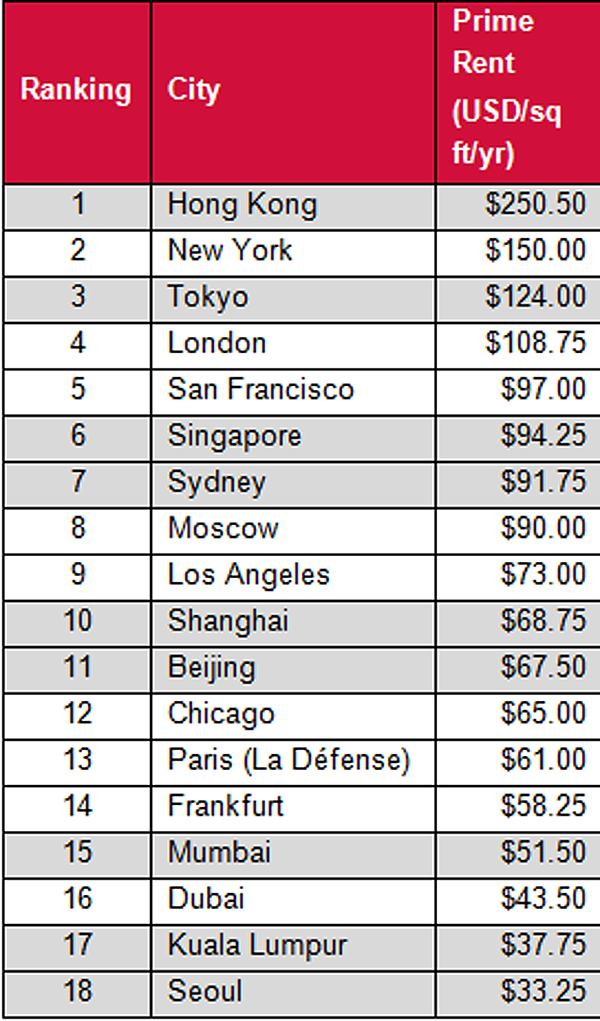Hong Kong tops the world when it comes to sky-high skyscraper rents, according to the latest research from Knight Frank.
Boasting the world’s highest skyscraper office rents at US$250.50 per sq ft, Hong Kong’s large lead in rents reflects a low vacancy rate and constrained CBD area.
However, New York is closing fast. While Asia may be building apace, economic recovery in the U.S. is buoying demand for towers from investors and tenants in the big North American cities.
Skyscraper prime office rents in New York have dramatically increased by 20 percent to hit US$150.00 per sq ft since July 2014, outperforming Hong Kong which increased by only 11.3 percent.
New York rental values have boomed as skyscraper development has increased, with towers proving popular workplaces for the expanding digital and creative firms in the city, as well as financial and professional firms. New York City’s population has also increased by 19 percent since 1980.
James Roberts, Chief Economist at Knight Frank, said: “We are now seeing the Western cities erode the lead of big Asian centres in tower office rents. For premium floors with views, rents are rising in Hong Kong, but they are increasing much faster in New York. Similarly, London is closing the gap on Tokyo.
“Economic growth prospects for this year favour locations like New York and London, so I see these cities stepping up competition on the Asian centres. Many people like to say that the balance in the global economy is shifting from west to east, but certainly skyscraper rents provide another indicator that shows this is not entirely the case.”
In 2009 there were 19 skyscrapers in the world with heights of over 1,000 feet. Today, there are 79 of them – 40 percent of which are in China and 28 percent of which are in the UAE.
Skyscrapers are a rising tide in the modern global city. London has added 23 new skyscrapers (a building over 350 feet high) since the turn of the millennium, compared to 17 in the preceding forty years, while New York added four new towers in 2014 alone, including the iconic One World Trade Center. This sounds impressive until one considers that Dubai has built nearly 190 skyscrapers since 2000 and Shanghai more than 90.
Nicholas Holt, Head of Research for Asia Pacific at Knight Frank, added: “The expansion upwards in the major Chinese cities has been a remarkable phenomenon over the past decade. The fact that 40 percent of skyscrapers in the world with heights over 1,000 feet are in China underlines the growing importance of the country’s economy on the world stage.”
Skyscrapers are not just popular with tenants, as they are also in vogue with real estate investors. This is the result of more mega-funds targeting property in recent years, sometimes sovereign wealth funds, but also national pension schemes and global private equity funds.
Recent examples include Blackstone purchasing 1740 Broadway and the Park Avenue Tower in New York for a combined US$1.1 billion, while in London the Qatari Investment Authority recently combined with Brookfield to buy the majority shareholding in developer Canary Wharf Group.
For funds which have very large amounts of money to deploy, sub-US$100 million deals can be too granular, however skyscrapers allow sums over the billion dollar mark to be invested in a single deal.
Changes in global capital markets are shaping the new trend, as the mega-funds have traditionally been major investors in sovereign bonds. Years of Quantitative Easing (QE) have pushed bond yields to record lows for some of the most popular triple A and double A sovereigns, making real estate yields comparatively attractive. QE has also encouraged many funds to diversify their investment portfolios, increasing interest in real estate as an alternative to bonds and equities.
Another attraction of skyscrapers relates to the diversity of the tenancy schedule found in many towers. Multiple tenants with leases expiring at different times increases exposure to the rental cycle, creating plenty of opportunity to asset manage a tower to exploit changes in the leasing market.
Particularly for pension funds, who must match income streams with long-term obligations, the longevity of skyscrapers is also an attraction. In New York, art deco towers from the 1930s still operate as modern office buildings. The prospect of a building that gains almost timeless appeal is of interest to an investor who must think very long-term.
As well as the mega funds mentioned above, we are even seeing interest in skyscrapers from private investors; as shown by Brazil’s Safra family buying 30 St Mary Axe. This could suggest a new club of skyscraper investors is emerging where the status factors found in leasing tower space are also applied to owning one.
Andrew Batt, International Group Editor of PropertyGuru Group, wrote this story. To contact him about this or other stories email andrew@propertyguru.com.sg






